Christine Valters Paintner's Blog, page 68
April 3, 2020
A Different Kind of Fast: Part Seven – Embrace Mystery
Dear monks, artists and pilgrims,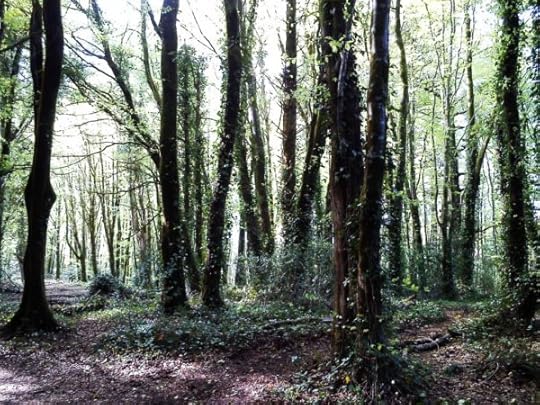
Let mystery have its place in you; do not be always turning up your whole soil with the plowshare of self-examination, but leave a little fallow corner in your heart ready for any seed the winds may bring, and reserve a nook of shadow for the passing bird; keep a place in your heart for the unexpected guests, an altar for an unknown God.
— from Amiel's Journal, translated by Mrs. Humphrey Ward
John Cassian, one of the ancient desert fathers, describes three renunciations he says are required of all of us on the spiritual journey. The first is our former way of life as we move closer to our heart's deep desires. The second is the inner practice of asceticism and letting go of our mindless thoughts. The third renunciation is to let go of our images of God—the idols we cling to so tightly—and to recognize that any image or pronouncement we can ever make about God is much to small to contain the divine. Even the word "God" is problematic because it carries with it so many interpretations and limits based on our cultural understandings.
We live in an age when fundamentalism has emerged as an overwhelming force in religious consciousness. In times that are chaotic and uncertain, our human minds grasp for a sense of control. One of the ways we try to make sense of things is to engage in black and white thinking. Establishing clear rules for how the world works, and who is inside and outside of God's sphere, is a way of coping with this felt loss of an anchor or shared cultural sense of meaning.
The via negativa or apophatic way in Christian tradition, which means the way of unknowing, demands that we talk about God only in terms of negatives, or what God is not. It helps to cleanse us of our idols. Alan Jones, in his book Soul-Making, writes, "We can only say that God is both unknowable and inexhaustible." Humility is required. We are so attached to our ideas of who God is and how God works in the world. Ultimately, what the desert journey demands is that we let go of even this false idol and open ourselves to the God who is far more expansive than we can behold or imagine.
Letting go of our images of God can be terrifying. It is often the result of an experience of suffering in our lives, when our previous understanding is no longer adequate to give meaning to what has happened to us. When my mother died suddenly in my early thirties, I was thrust into the desert. All of my certainties about God and life were stripped away and I was left raw and frightened. Many people offered trite words and shallow comfort in my grief, they were not willing to sit with me in the darkness, but only hoped to rush me through to a place of light.
This is the mystical experience of the "dark night of the soul," when old convictions and conformities dissolve into nothingness and we are called to stand naked to the terror of the unknown. We must let the process move through us—one which is much greater than we can comprehend. We can never force our way back to the light. It is only in this place of absolute surrender that the new possibility can emerge. We don't just have one dark night in our lives, but again and again, as we are called to continue releasing the images we cling to so tightly.
Sheri Hostetler is a Mennonite poet whose poem "Instructions" begins, "Give up the world; give up self; finally, give up God." Her choice of words is certainly provocative and when I have read this poem in classes and on retreats, I encounter a wide range of reactions from a visible sigh of relief to the anxious confusion over whether I am proposing a kind of atheism.
In some ways I am, at least in the way that Christian mystic Simone Weil speaks about it. She tells us that "there are two atheisms of which one is a purification of the notion of God." This is the call of the desert elders: to let go, let go, let go, and let go some more, on every level of our lives, to everything we cling to, including, or especially our ideas about God. As soon as our human minds begin to fashion categories, we risk making idols of them.
We let go of who we are certain God to be and cultivate an openness to the One who is far beyond the horizons of our imagining. In the Book of Job, God challenges Job's desire for understanding and asks "where were you when I laid the foundation of the earth?" God is never a set of concepts to be understood and grasped, but a relationship to encounter and engage. In this way, the spiritual life is always a journey and in process. We do not let go once and for all, but move through the layers of clinging in our lives until we are living more from our hearts than our minds. We do not arrive, but travel toward the horizon, realizing that it is always receding from our view.
This Lent I will fast from the places in my life where I crave certainty and sure outcomes, and release them to the great Mystery. I will celebrate a God who is infinitely larger than my imagination and I will rest in the possibilities that affords.
With great and growing love,
Christine
Christine Valters Paintner, PhD REACE
Photo © Christine Valters Paintner
Celtic Practice of Thresholds Webinar
We have collectively entered into a time and space of threshold, when the old has fallen away and the new has not yet come into being. In the Celtic imagination, thresholds were places where the veil between heaven and earth was especially thin and so we had access to a deeper connection with the spiritual wisdom of the divine, of the saints and mystics, and of our ancestors.
Paraclete Press invited Christine Valters Paintner to speak about Celtic wisdom for the times we are in. Below is the recording of the session which includes teaching, meditation, and poetry.
This is the passage we used for our lectio divina practice:
Stand at the crossroads and look, and ask for the ancient paths,
Where the good way lies, and walk in it, and find rest for your souls.
(Jeremiah 6:16)
Closing poem "You Are Here" is from Christine's forthcoming collection The Wisdom of Wild Grace
You Are Here
(after Rainer Maria Rilke's Book of Hours)
You are the now and not-yet, the darkened dawn just before
the first rays rise and you are the rays that pierce and prod.
You are the siren screeching through city streets
dropping me to my knees in prayer.
You are the lilac and the dust,
the refugee's body found on shore with empty pockets.
You are the wound that does not heal, the salve,
the bandage, and the raised scar that remains.
You are the dandelion growing through concrete cracks,
the mirror smashed into pieces, the mosaic created.
You are the vigil for my mother dying, you are the steady beep
of the heartrate monitor and the long tone that makes me wail.
You are ash from the burning towers
the great gashed tree felled by storm, now moss-coated, silent,
You are the grey headstone and the red bird that lands and sings,
the gaunt face I ignore while rushing down the street.
You are the old man's spectacles
and the love letters from his wife now gone.
You are thick grime, a sob stuck in the throat,
the voice long silent speaking once again.
April 1, 2020
Earth Monastery Virtual Book & Album Launch
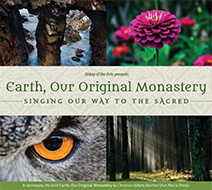
EARTH DAY: Wednesday, April 22, 2020 at 12 noon Eastern
(9 am Pacific/5 pm Ireland/UK)
Christine Valters Paintner will be joined by Abbey of the Arts Wisdom Council members Betsey Beckman, Simon de Voil, and Richard Bruxvoort Colligan for this free hour-long event.
Christine will introduce and share a meditation from the book Earth, Our Original Monastery, Simon and Richard will share songs from the album, Betsey will lead us in embodied prayers, and Christine will read poems from her forthcoming collection this fall, The Wisdom of Wild Grace. Celebrate with us these important resources for our times!
There will also be a chance to win some special prizes for those attending live. (The event will be recorded for those who can't participate live).

REGISTER to join the event live
ORDER the Earth, Our Original Monastery book
REGISTER for the summer online retreat
ORDER the Earth, Our Original Monastery album
PRE-ORDER The Wisdom of Wild Grace: Poems

SUBSCRIBE to the Abbey of the Arts email list
Visit RICHARD's website Worldmaking
Visit SIMON's website
Visit BETSEY's website The Dancing Word
SUPPORT Richard's music on Patreon
SUPPORT Simon's music on Patreon
March 31, 2020
Monk in the World Guest Post: Marilyn Freeman
I am delighted to share another beautiful submission to the Monk in the World guest post series from the community. Read on Marilyn Freeman's reflection "Cinema Divina: Another Way of Seeing Seeing." This is an excerpt from her new book The Illuminated Space: A Personal Theory & Contemplative Practice of Media Art published by The 3rd Thing Press, 2020.
I go out shooting video regularly, not necessarily every day, but sometimes multiple times in a day. When I'm shooting, I'm guided by four words: read, reflect, respond, rest. The fact they each start with the letter "r" helps when I want to call my mind back to this practice, which is often. This way of shooting is a contemplative practice I've derived from an ancient prayer process called lectio divina or "sacred reading." I call what I do Cinema Divina.
Lectio divina is a central practice of Catholics in the Benedictine order. It is a contemplative way of praying that can be traced to Jewish mysticism. In order to experience an unmediated connection with the Divine, mystics read passages of sacred texts slowly and repeatedly through a series of meditative steps, usually four, sometimes more. My four simple "r" words are rough translations from the Latin lectio, meditatio, oratio, contemplatio.
This creative contemplative practice I've cultivated isn't rigid. Rather, Cinema Divina is a structured but fluid way for me to bring increasing awareness to all parts of my creative process—from shooting through screening. To see what I'm seeing. Read, reflect, respond, rest. Repeat.
Read
So, my camera is set up and on, and my frame is set. I am shooting, recording. My vision is trained on the viewfinder. I think of this initial phase as "reading." I'm reading the image in the viewfinder: noticing the whole composition, noticing objects, people and other animals, noticing movement or activity within the frame, noticing colors, shapes and being attentive to what most draws my attention. I ask what is the image offering.
I take it in as wholly as possible, I see all I can see, I am alert for what interests me, but I am not authoring anything yet, not editing anything out or adding anything, not making meaning. I am reading the image in the viewfinder with the curiosity, surprise, irritation or boredom I might read any text.
While trained on my viewfinder, I don't block out everything else. I remain cognizant of my surroundings. And I am very aware of sounds and that they are being recorded concurrently with the video image. I always record the location sound, usually just using the camera's rudimentary on-board microphone.
After a while, l look around a bit, stretch, breathe and I let myself notice what is staying with me—an object, the way the light is moving, cars passing in the distance or people walking through the shot, the sky. I let myself be with this process for a bit without really pushing.
Reflect
Then, I return to my viewfinder to reflect on what I'm seeing, to sink deeper into what most calls to me. If I were doing a traditional lectio practice I would read the text again. But I'm shooting, and in this practice the image and I are moving along together with the flow of time.
A question I use to guide my reflection is What is this scene stirring in me, stirring in my life? I observe any feelings, thoughts, associations, memories, regrets, prayers, insights, questions that arise? I actively notice the affect on me, in me, of what I'm seeing—what it stirs in my heart. Am I excited, tired, anxious, relaxed, annoyed, distracted, hopeful, sad, disappointed? I stay with this for as long as feels right.
Respond
Then I turn my attention to responding to what I'm seeing and to what it has stirred in me. At this point, and this may be several minutes into shooting this particular scene with this particular framing, I'm asking, What is the invitation? It might be an invitation to take action—to do something or to stop doing something. To be aware of a way of being or thinking. To slow down. To let go. To go deeper. I notice if there is anything in me that longs to be expressed.
I consciously breathe in order to keep myself awake to this contemplative practice, to be aware of what arises in my heart, to let myself respond: to be affected. I linger here as long as feels right, continuing all the while to see what I'm seeing.
Rest
And then, still recording, I rest in contemplation with what is opening in my heart. I let go of actively reading, of reflecting on and responding to what I'm seeing in the viewfinder. If I were doing a traditional lectio divina I would close my eyes and rest in silence. At this point in my Cinema Divina practice I let the camera's frame, and the fact that it is still recording, hold me in a resting, attentive state.
I settle into what has emerged from the process, what it has conjured in me, what has opened my heart, how I want to bring this into my life and into my art. I might formulate an intention, a wish, a prayer…or it may not take any form. Rest is rest. For me, this resting will most often feel both lovely and loving. Without aiming for it, I'll often feel connected, part of everything. This process tends to feel nurturing. And nourishing. Not always, but often, it fills me with a sense of wellbeing.
~ ~ ~
I invite you to watch How Long Will You Sleep, a selection from Cinema Divina, short films made for contemplation:
How Long Will You Sleep from Marilyn Freeman on Vimeo.
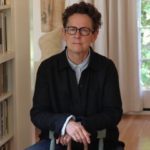 Media artist, writer and spiritual director, Marilyn Freeman, is author of The Illuminated Space: A Personal Theory and Contemplative Practice of Media Art (2020) and creator of Cinema Divina–short films for contemplative practice. Freeman's work screens on PBS, in movie theaters and galleries, at spirituality centers and film festivals worldwide. MarilynFreeman.com
Media artist, writer and spiritual director, Marilyn Freeman, is author of The Illuminated Space: A Personal Theory and Contemplative Practice of Media Art (2020) and creator of Cinema Divina–short films for contemplative practice. Freeman's work screens on PBS, in movie theaters and galleries, at spirituality centers and film festivals worldwide. MarilynFreeman.com
The Illuminated Space is available at The 3rd Thing Press
March 28, 2020
Love Note, Gratitude, and the Soul of a Pilgrim ~ A Love Note from Your Online Abbess
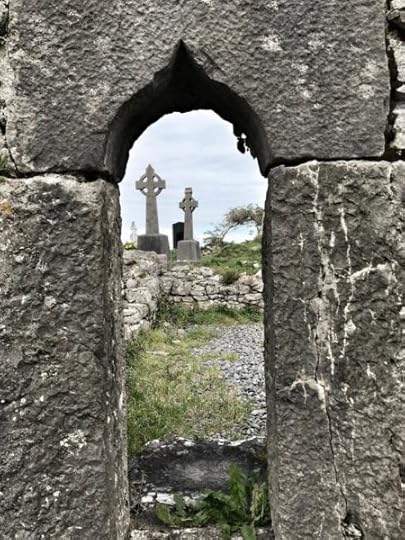 Dear monks, artists, and pilgrims,
Dear monks, artists, and pilgrims,
It is safe to say John and I never imagined the final quarter of our sabbatical year would be spent in quarantine and compassionate retreating during a pandemic. Of course, what makes this so unsettling for many of us is how quickly it has spread and all of a sudden our lives are disrupted in ways we hadn't even imagined a few weeks ago. None of us ever knows what is coming in the next moment. All we can do is practice presence and prepare ourselves to become steady and resilient in the face of the coming storm.
It will take me a while to unpack the many gifts we have already received from sabbatical, gifts that have come both from extensive ancestral travel I was able to make time for and the lovely long spans of time at home in quiet rhythms and working on book projects.
Some of what we have come to discern is how nourishing it is for us to be at home and how tiring travel can be, especially for me, as someone with rheumatoid arthritis and a whole adulthood of fatigue. Entering menopause has also compounded my tiredness. And so we had already been contemplating how that might affect our future rhythms.
Then this disruption descends. As I am sure most of you have, I also have experienced my own moments of anxiety over what this means for our financial well-being with so many live programs coming up and also over my health as someone who takes an immune suppressant drug to manage my illness. Those are all very real concerns and not to be denied.
And yet, what has brought me tremendous joy and a deepened sense of purpose has been the Novena for Times of Unraveling which just ended this week on the feast of the Annunciation. Only two weeks before, on a restless night, the call came to me to offer this gift to our community and I am so grateful to have said yes. Even more so I am grateful for the over 4000 pilgrims and monks who also said yes to register and join us. The live sessions felt like such a powerful connection of love across the globe. These ancient mystical practices matter. They give us an orientation in times of confusion and loss. They connect us to the ground of love when our hearts are broken open.
The spiritual life isn't about pretending everything is great because we believe in God. That is a form of spiritual bypassing, of not taking seriously the pain and suffering of the world. Instead, we are called to be present to the grief, the sorrow, the rage that is stirred in these times and make space for them. We are also called to make space for kindness, compassion, gratitude, and wonder within us too.
On Day 7 of our Novena our practice was gratitude which can open our hearts and shift our awareness from scarcity to abundance, from fear to love. There are a thousand things each day I am grateful for, from the simplest of moments, of food and companionship, of meaningful work, and much more. But that expression of gratitude is never a denial of the anxiety and suffering. We must hold them together in tension. Living into the paradox of a world of terrible cruelty and sorrow with a world of spectacular beauty and moments of extraordinary kindness is what it means to be a mature contemplative. To honor the both/and of our human experience.
When my initial anxiety over what all this would mean for us subsided, I was left with a clear sense of purpose. I knew that the ancient wisdom of monks and mystics had a gift for all of us today trying to live in meaningful and transformative ways. I have centered my life's work on it, but somehow now, it feels even more vital. Perhaps because these are the kinds of circumstances which test us. Being grounded in contemplative practices doesn't mean we don't feel fear and anxiety, but it does mean we have deep resources that can steady us. It means we might be moved to more appreciation and kindness in the moment. It means we have practiced leaning into the Mystery and learned to grow a bit more at ease with unknowing.
Our Novena journey came to an end this week, but of course, like a pilgrimage that journey continues on in our hearts. Anyone is welcome to still access those materials. With so many expressing their heartfelt appreciation of this experience and the opportunity to connect, John and I discerned, what now? How do we continue to honor our sabbatical time and also offer resources and support during an unprecedented crisis. For now we have discerned an offering our Soul of a Pilgrim online retreat in community (April 13-June 7, 2020) which companions my book of the same title. The themes explored in this book and retreat, are themes that serve us well right now as we are all making a pilgrimage through the wilderness with no certainty of where we are heading. There is a sliding scale for payments so please feel welcome to join us whatever your financial circumstances.
So for now, our sabbatical continues. I will be showing up each Monday for 8 weeks during the next online retreat to offer more live webinars because they truly bring me much joy. We will rely on our wonderful facilitators Melissa and Amber to hold the space in the forum and witness the deep sharing and creative expression that will emerge. I can continue writing the books I am working on and keep spaciousness to my days. My own daily practices of meditation, yoga, and journaling have become lifelines and compasses. It feels like grace to be able to respond to a genuine need and I have been praying a lot with the story of Jesus healing on the Sabbath to listen into what the call is for this season now. What does sabbatical mean in light of a global pandemic? How might this sacred space I am standing in shed new light? Can I be of service and also stay grounded in a time of renewal?
I do hope to offer more reflections on Sabbath time in the coming weeks. For now, suffice it to say that we are enormously grateful for this community of kindred souls. Thank you to each of you for bringing more kindness, compassion, and love into the world. We are all in this together.
With great and growing love,
Christine
Christine Valters Paintner, PhD, REACE
Photo © Christine Valters Paintner
March 27, 2020
A Different Kind of Fast: Part Six – Embrace Organic Unfolding
 Dear monks, artists and pilgrims,
Dear monks, artists and pilgrims,
* This is the sixth part of a seven-part series we will publish weekly during this Lenten season.
It was said of Abba Agathon that for three years he lived with a stone in his mouth, until he had learnt to keep silence. (Agathon 15)
The silence of the desert elders is called hesychia, which means stillness, silence, inner quiet. However, it is much deeper than just an external quiet. A person can live alone and still experience much noise within and a person can live in the midst of a crowd and have a true sense of stillness in their heart.
There is always a shadow side to silence—the kind of silence that keeps hidden secrets and abuses. This is not the life-giving silence the desert elders seek. Silence can be poisonous, as when someone's voice is being silenced or when we silence ourselves out of resentment or anger. Think of times when you have engaged silence as a weapon in a relationship. There is also the silence of hopelessness or giving up, feeling overwhelmed by life. Or silence that comes when we feel another has all the answers and our voice doesn't matter.
The desert monks are talking about silence that is life-giving. They urge us to seek a particular quality of silence that is attentive and emerges from a place of calm and peace. Our freedom to be silent in this way indicates our freedom from resentment and its power over us. Authentic silence is very challenging to achieve.
Meister Eckhart wrote, "There is nothing so much like God as silence." When we experience moments when we find ourselves releasing words and simply entering into an experience of wonder and beholding, this is the silence of God, moments when we are arrested by life's beauty.
Silence is challenging. We create all kinds of distractions and noise in our lives so we can avoid it. Thomas Merton writes about people who go to church and lead good lives but struggle with quiet:
Interior solitude is impossible for them. They fear it. They do everything they can to escape it. What is worse, they try to draw everyone else into activities as senseless and as devouring as their own. They are great promoters of useless work. They love to organize meetings and banquets and conferences and lectures. They print circulars, write letters, talk for hours on the telephone in order that they may gather a hundred people together in a large room where they will all fill the air with smoke and make a great deal of noise and roar at one another and clap their hands and stagger home at last patting one another on the back with the assurance that they have all done great things to spread the Kingdom of God.
Merton is fierce in his critique of all the ways we cling to words to feel productive, while never making space to surrender into the unknowing of silence and experience silence as beyond all of our good words and intentions. Silence is what makes our actions meaningful, not the other way around.
Silence encourages us to release our desire to control the outcomes of everything and enter into the organic stillness from which new fruit can arise. When we rush and spread ourselves between too many commitments, and saturate our lives with noise, it becomes impossible to truly hear.
When I am immersed in planning my life, writing list after list of things to do, and always trying to meet the next deadline, I am called to pause from these things. For Lent I will fast for a while from my endless desire to control the direction of my life. I will open myself to the grace of silence, in which beauty comes alive and there are things already ripening and unfolding. From this space a garden can flourish.
With great and growing love,
Christine
Christine Valters Paintner, PhD
Photo © Christine Valters Paintner
Monk in the World: Sabbath 5 – Suggestions for Practice ~ A Love Note from Your Online Abbess
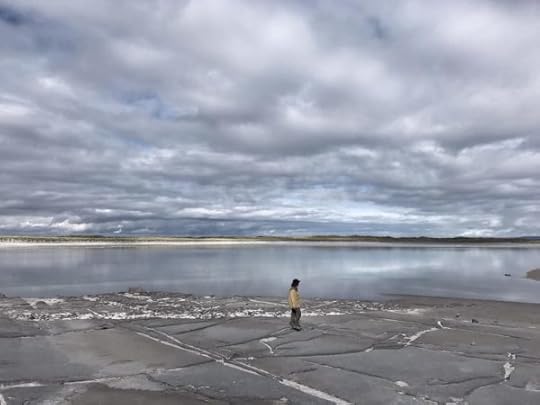 Dearest monks, artists, and pilgrims,
Dearest monks, artists, and pilgrims,
During this Jubilee year of sabbatical we are revisiting our Monk Manifesto by moving slowly through the Monk in the World retreat materials together every Sunday. Each week will offer new reflections on the theme and every six weeks will introduce a new principle.
Principle 6: I commit to rhythms of rest and renewal through the regular practice of Sabbath and resist a culture of busyness that measures my worth by what I do.
Suggestions for Practice
See if you can block out one day in the coming week for honoring Sabbath and renewing your spirit. If not a day, then begin with a few hours. Enter into this time with intention, setting aside work and worry and allowing yourself time for silence, play, and friendship. Consider creating a small ritual for beginning and ending to honor your Sabbath time – perhaps lighting a special candle, saying a blessing, and offering a gesture of receiving the gifts ahead.
With great and growing love,
Christine
Christine Valters Paintner, PhD, REACE
Photo © Christine Valters Paintner
March 25, 2020
Soul of a Pilgrim Online Retreat in Community

with Christine & John Valters Paintner, and Jamie Marich
Facilitated by Melissa Layer and Amber Andreasen
April 13-June 7, 2020
You are also warmly invited to join us for The Soul of a Pilgrim, an online retreat in community starting April 13 for 8 weeks. We will deepen into our exploration of what it means to be a pilgrim in these challenging times and what wisdom the pilgrim way has to offer us and our world. Christine will be doing a weekly live session and our forum will be lovingly facilitated. Lots of creative practices as well. There is a sliding scale, so anyone who wants to is encouraged to join our sacred caravan through the wilderness.
March 24, 2020
Monk in the World Guest Post: Michael Moore
I am delighted to share another beautiful submission to the Monk in the World guest post series from the community. Read on for Wisdom Council member Michale Moore's reflection, "The Contemplative Life in the time of COVID-19 Novel Coronavirus."

This is a Bull Elk that was snoozing on our Church property (Presbyterian Community Church of the Rockies in Estes Park, Colorado) after a day of clashing with other Bulls during Rut which is their "mating" season in the Fall here in the Rocky Mountains. His competitor was actually snoozing about 100 yards away… the competitor had lost the clash and was also exhausted on the outskirts of the harem.
This has been a season of concern, fear, frustration, and exhaustion for my wife Denise and me as we guide the congregation which I serve through this time of difficulty. To be honest, I have had to limit my intake of 24/7 news in much the same way I had to while I was serving as a Chaplain in the US Air Force when the attacks of September 11th, 2001 occurred and we went from "exercising" to really shutting down a base and protecting it from any further attack. I am also having some flashbacks to wartime maneuvers and deployments as I lead this congregation through a situation they cannot comprehend. Trust me, this Padre is having a hard time wrapping his heart and head around this situation.
So, you might wonder how we are trying to cope and center ourselves spiritually as Denise and I work frantically to bring virtual worship and fellowship to our community of faith. It has been a long and intense slog through the mud (or in our case, snow). What are we doing personally to persevere? We are trying to center ourselves through the practice of Daily Prayer. We try to begin the morning with the Office of Morning Prayer from the Northumbria Community's Celtic Daily Prayer which is available through Amazon or Amazon Kindle.
It seems lately that most of the time we Pray the Office of Compline before we fall into bed exhausted. These moments together in prayer help us to center and relax.
Another discipline that has been important to me has been my daily readings from Thomas Merton's varied words of prose and poetry. And yet another source of support and warmth has been with Christine and John along with our Holy Disorder of Dancing Monks community. We have a variety of self-guided retreats and the daily emails with quotes and blogs that nourish.
My dear Dancing Monks, these are indeed interesting times. I researched this quote, and this "curse" has no basis in Chinese legend and in these times of rising racism we must not call it a "Chinese Curse." Instead we are living in unusual and scary times. I believe that as we approach self-isolation or even "Shelter in Place" as communities and states, that we are called as Monks in the World to pray and to be a witness to the Love, Grace, and Light of the Spirit however you may define Her, the Spirit (which is how I describe (the spirit of God, Ruach) in my own faith journey).
We used to say in the military that we weren't in a Sprint, but rather a Marathon. Much love to each of you as we live, love, pray, and share that Divine Light throughout this marathon. I'll close with a favorite prayer of mine from Thomas Merton which always offers me comfort and hope, especially during these trying times.
My Lord God,
I have no idea where I am going.
I do not see the road ahead of me.
I cannot know for certain where it will end.
nor do I really know myself,
and the fact that I think I am following your will
does not mean that I am actually doing so.
But I believe that the desire to please you
does in fact please you.
And I hope I have that desire in all that I am doing.
I hope that I will never do anything apart from that desire.
And I know that if I do this you will lead me by the right road,
though I may know nothing about it.
Therefore will I trust you always though
I may seem to be lost and in the shadow of death.
I will not fear, for you are ever with me,
and you will never leave me to face my perils alone.
Thomas Merton, Thoughts in Solitude , 1956
 Michael Moore is a retired USAF Chaplain and pastor in the Presbyterian Church (USA) who currently lives in Estes Park, Colorado with his wife and partner in life and ministry, Denise. His undergraduate degree is in Business Administration (University of Wisconsin at Eau Claire) and he earned his Master of Divinity degree from United Theological Seminary of the Twin Cities (Saint Paul, MN). He served two small yoked Presbyterian Churches in rural Fergus Falls, MN for three years before going on Active Duty with the USAF for 21 years. Following his retirement, he served a church in Florida for four years before going to his current call in Estes Park in 2015. He has a Certificate in Christian Spiritual Formation from Columbia Presbyterian Theological Seminary in Decatur, GA.
Michael Moore is a retired USAF Chaplain and pastor in the Presbyterian Church (USA) who currently lives in Estes Park, Colorado with his wife and partner in life and ministry, Denise. His undergraduate degree is in Business Administration (University of Wisconsin at Eau Claire) and he earned his Master of Divinity degree from United Theological Seminary of the Twin Cities (Saint Paul, MN). He served two small yoked Presbyterian Churches in rural Fergus Falls, MN for three years before going on Active Duty with the USAF for 21 years. Following his retirement, he served a church in Florida for four years before going to his current call in Estes Park in 2015. He has a Certificate in Christian Spiritual Formation from Columbia Presbyterian Theological Seminary in Decatur, GA.
A writer and photographer, you can find him blogging at Pastor Michael Moore or at GodSpace as a member of that community.
Earth, Our Original Monastery Album
 We have a brand new album out now with 14 beautiful songs to cultivate our intimacy with Earth. So grateful to our musicians Richard Bruxvoort Colligan, Simon de Voil, Betsey Beckman, Lorraine Bayes, and Peter Mayer for sharing their gifts with Abbey of the Arts. The album accompanies Christine's newest book and soon there will be dances to accompany all the songs as well!
We have a brand new album out now with 14 beautiful songs to cultivate our intimacy with Earth. So grateful to our musicians Richard Bruxvoort Colligan, Simon de Voil, Betsey Beckman, Lorraine Bayes, and Peter Mayer for sharing their gifts with Abbey of the Arts. The album accompanies Christine's newest book and soon there will be dances to accompany all the songs as well!  The album is available as a CD or a digital download. Special discount if you purchase the digital download of all three of our albums.
The album is available as a CD or a digital download. Special discount if you purchase the digital download of all three of our albums. 
Order the album as digital download or CD here>>



